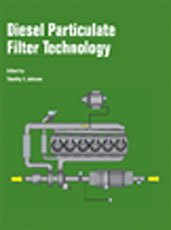Technical Paper
Evaluation of an On-Board, Real-Time Electronic Particulate Matter Sensor Using Heavy-Duty On-Highway Diesel Engine Platform
2020-04-14
2020-01-0385
California Air Resources Board (CARB) has instituted requirements for on-board diagnostics (OBD) that makes a spark-plug sized exhaust particulate matter (PM) sensor a critical component of the OBD system to detect diesel particulate filter (DPF) failure. Currently, non-real-time resistive-type sensors are used by engine OEMs onboard vehicles. Future OBD regulations are likely to lower PM OBD thresholds requiring higher sensitivity sensors with better data yield for OBD decision making. The focus of this work was on the experimental evaluation of a real-time PM sensor manufactured by EmiSense Technologies, LLC that may offer such benefits. A 2011 model year on-highway heavy-duty diesel engine fitted with a diesel oxidation catalyst (DOC) and a catalyzed DPF followed by urea-based selective catalytic reducer (SCR) and ammonia oxidation (AMOX) catalysts was used for this program.


